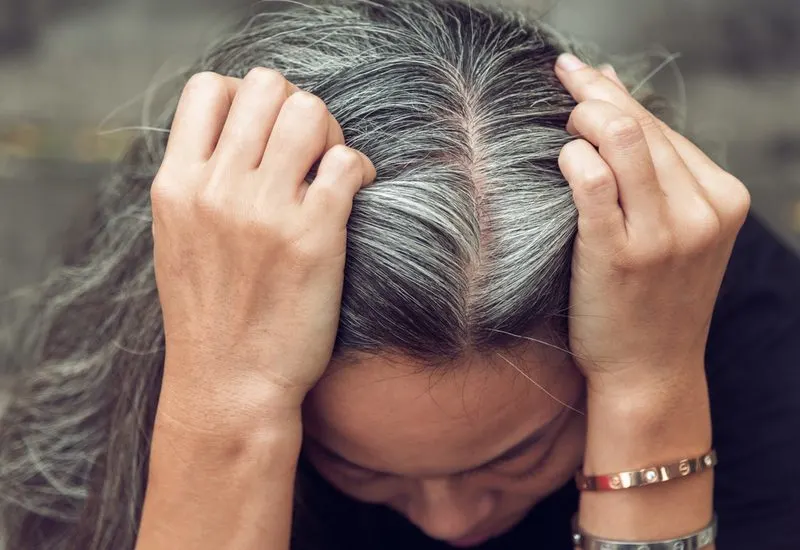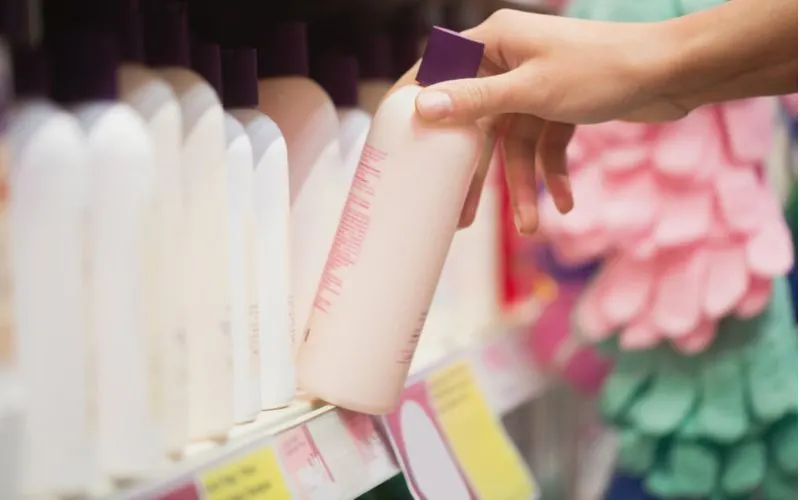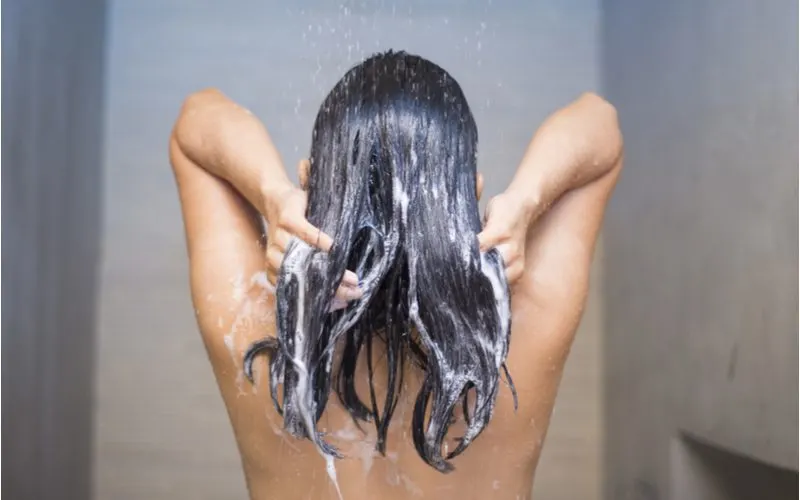Jump to:
Hair color trends are always developing. Long gone are the days when buying a box of dye at the pharmacy or making a trip to the salon for your typical color appointment were the only options.
People now have unprecedented access to professional-level hair color they can use at home, and a wealth of online tutorials to walk them through it.
This access, however, came with a caveat: hair damage. Using harsh dyeing chemicals – particularly those used to create today’s popular bright alternative hair colors – can wreck the condition of your hair.
While experimenting with new looks can be a lot of fun, over time, the damage can be quite serious, leading to dryness, discoloration, breakage, and sometimes, even significant hair loss. We’ll show you how to avoid this dreaded outcome below.
The Rise of Color-Depositing Conditioner

Alliance Images/Shutterstock
These products have been around for a while but hit their stride over the last 2 to 3 years. Color depositing conditioner offers the attractive possibility of coloring your hair AND making it healthier.
Sounds too good to be true?
Thousands of satisfied users have been singing the praises of these trending formulas, and indeed, with a few recommendations. We explain in this article what color-depositing conditioners are, how they work, and what the best ways are to use them.
What Are Color-Depositing Conditioners?
Color depositing conditioners combine deep conditioning agents with concentrated pigments for an all-in-one hair treatment that makes hair softer, shinier, more manageable, and sporting a bright new look.
But they’re temporary, which means they wash out within 5 to 15 washes, depending on the color and brand of the product and your hair type. Color-depositing conditioners go back a long way.
Their roots are in the henna products that were trending in ancient Egypt as far back as 1200 BCE, and for centuries after that, the only colors available were shades of black, brown, and auburn. Today, we can get color-depositing conditioners and choose from an amazing array of color choices.
Then, we can mix them to create custom colors. This is one reason they are a superb choice for trying on new or bold hair colors without the damage or commitment of bleaches and dyes.
What Color Depositing Conditioner Can Do

Waewkid/Shutterstock
Conditioning
The primary function of a conditioner is to improve the overall look and health of the hair. The lotion smooths the hair shaft, softens the hair, and makes it less prone to tangling
Continued use of any high-quality conditioner will improve the appearance of the hair and make it easier to manage.
Color-depositing conditioners do just that, and because the most popular formulas are on the better quality end of the hair-care spectrum, they contain ingredients that do the job well.
Coloring
Most people who try color-depositing conditioners aren’t usually in it just for the conditioning; they want that coveted color!
Ads for the most popular brands of these conditioners show models with impressive heads of colorful hair, often in the vibrant crayon colors or pastels that are sought-after these days. But can color-depositing conditioners yield these results? Yes and no.
Certain types of high-quality color-depositing conditioners contain large concentrations of pigments, and they can work beautifully, albeit temporarily, to add bright or pastel colors to light hair.
If you have natural, platinum blonde, or silver hair, or if you pre-bleached it, you can get an impressive result. But color-depositing conditioners can’t deliver paint-like colors or pastel hair to those with darker tresses.
It can, however, add a very noticeable cast of coloration over the darker hair. So it can still significantly change up the look of your hair. Overall, it is best to use a color-depositing conditioner to enhance your hair color rather than drastically change it.
Covering Gray
For covering gray, a color-depositing conditioner is usually not the best option. While it can give a cast of color over the gray, it will not cover it up and blend it into the rest of your hair like a permanent dye can.
Gray, covered by color-depositing conditioners, will still be a different color from the rest of your hair. It may also fade more quickly since the porosity of gray hair differs from that of colored hair.
Some people like the highlight effect that color-depositing conditioners give to gray hair; others perhaps not so much. It is a matter of taste. While it’s great to go in with realistic expectations when using a color-depositing conditioner, it’s also nice to have fun!
Here we have a product that lends itself well to experimentation. If you don’t like the results, you can live in the comfort of knowing that this is not the end of the world because they don’t last forever and cause no damage to your strands.
Read Next: Best Conditioner for Gray Hair
Types of Color-Depositing Conditioners

As previously mentioned, there are types of color-depositing conditioners that are made to be used much like a dye. They’re applied to wet or dry hair, left on for a set amount of time – usually anywhere between 10 minutes and half an hour – then washed out.
These types are the most likely to deliver strong color results that can mimic a traditional dye. In-shower color-depositing conditioners are also an option. While brands vary, many of these are used to boost and maintain natural or dyed hair colors.
They add color to hair slowly and generally give a more subtle effect. We can also use them to tone hair color. The most popular types of conditioners for this purpose are blue rinse for silver hair and purple rinses for blonde.
But there are many other options available. What you can expect from color-depositing conditioners largely depends on what kind it is and how you use it.
How to Use Color-Depositing Conditioner
Let’s go over the basics of how to use the most popular types of color-depositing conditioner. These are just general guidelines.
You must read all instructions on the brand and type of color-depositing conditioner you are using. They vary, and if you want to get excellent results, you need to follow the instructions closely.
The Hair Dye Method
- Start with either damp or dry hair depending on the product’s directions.
- Detangle hair before adding color. This will ensure that you cover hair evenly and smoothly.
- Using clips, section hair off into four sections; two on the front of your head and two near the back. Decide where you want your color to go.
- Using a hair color brush or your hands, begin applying the conditioner to the desired areas. Some people want full-head coverage; others may want to create an ombre effect or streaks. It’s up to you. Just make sure you section hair accordingly and concentrate on the right spots.
- Once you have applied the color, leave it on for the time listed in the box instructions, usually around 15 minutes on average. You can choose to leave it on for a longer or shorter time based on how strong you want your results to be.
The In-Shower Conditioner Method
- After shampooing, apply an appropriate amount of conditioner to the hair.
- Work conditioner through all sections of hair where you want the color to be.
- Use a shower conditioner brush to help with the process. This little tool also clears any tangles that can block full coverage.
- For best results, allow the conditioner to sit on hair for a few minutes.
- Rinse out.
Maintaining Your Results

Color-depositing conditioners aren’t permanent dyes, so you will inevitably see some fading after a few washes. However, there are ways to help the color last longer.
Use a Color-Depositing Shampoo
Color-depositing shampoo is often sold as a bundle with a color-depositing conditioner. Color-depositing shampoo adds another punch of color to your hair and acts in harmony with your conditioner to help you achieve and maintain longer-lasting color results.
Switch to a Sulfate-Free Shampoo
Harsh chemicals in some shampoos can strip the natural oils from your hair and may compromise the integrity of color pigments.
Making the switch to natural shampoo, particularly one without sulfates, is a good idea when you’re using a color depositing conditioner. Your color will last longer, and your body will thank you.
Keep Up Your Treatments
The best way to maintain the results of your color-depositing conditioner is to keep to a regular coloring schedule. Most color-depositing conditioners are used anywhere between one and three times a week.
But some people choose to go longer between treatments. This depends on what brand you’re using and what your goals are.
Every hair type is distinct, and each brand works differently, too. Some trial and error will show you which brands and which coloring schedule helps your color last longest for you.
Tackling Color-Depositing Conditioner Stains
It’s no surprise that a product designed to penetrate hair deeply will stain everything else as well. Anyone who has used a color-depositing conditioner will tell you that these products will put stubborn stains on walls, furniture, counters, clothing, hands, and foreheads.
Most color conditioning kits come with gloves included, but any type of protective gloves will do. As with any hair dye, you can use a plastic trash bag or dark towels to protect your clothes and your body.
The petroleum jelly with the hairline trick keeps hair color off your forehead, and the nape of your neck works with a color depositing conditioner just as well as with any dye. What about stains on surfaces? Hair coloring can be a messy business.
It’s not uncommon for a glop (or two, or 10) to end up on your bathroom sink, floor, or in the shower when you’re rinsing.
Thankfully, color-depositing conditioner stains usually respond well to bleach-based cleaners and those with hydrogen peroxide. For spot stains, try soaking with nail polish remover then wiping clean.
If your whole tub or shower ends up with a color cast over it, you can use bleach and water in a spray bottle. Spray, let sit for a while (at least 20 minutes), then rinse off. Repeat if necessary.
Read Next: How to Remove Permanent Hair Dye From Your Skin
So, How Do You Use Color-Depositing Conditioner?
So there you have it — how to use color-depositing conditioner. Now that you have some basic tips and tricks, there’s only one thing left to do. Put your knowledge to use! There’s a world of color waiting for you.
